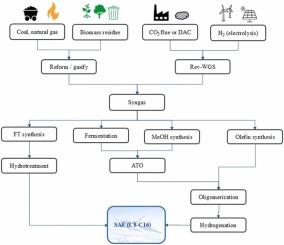Syngas to sustainable aviation fuel: Emerging catalysts and routes
IF 4.8
2区 化学
Q2 CHEMISTRY, PHYSICAL
引用次数: 0
Abstract
As the aviation sector needs to decarbonize, sustainable aviation fuel produced from syngas offers a promising pathway to decrease CO₂ emissions. A wide range of carbon sources including biomass, CO₂, and municipal and plastic waste can be used as sustainable feedstock to produce syngas. This review provides a comprehensive overview of all known routes for converting syngas into jet-range hydrocarbons, with particular emphasis on emerging catalytic approaches at low technology readiness levels. These include direct syngas-to-jet fuel range hydrocarbons (HCs) and syngas-to-olefins-to-jet fuel range HCs as well as routes with methanol- or ethanol as intermediate. We assess recent advances in catalyst design, such as bifunctional, core–shell, and tandem systems, and discuss how these compare to established pathways like Fischer–Tropsch synthesis, which is already certified under ASTM D7566. By benchmarking emerging technologies against ASTM-certified and near-commercial processes, this review identifies key opportunities and technical challenges that must be addressed to accelerate the deployment of syngas-based SAF solutions.

合成气到可持续航空燃料:新兴催化剂和路线
由于航空业需要脱碳,从合成气中生产的可持续航空燃料提供了减少二氧化碳排放的有希望的途径。包括生物质、二氧化碳、城市垃圾和塑料垃圾在内的各种碳源都可以作为生产合成气的可持续原料。这篇综述全面概述了所有已知的将合成气转化为喷气式碳氢化合物的途径,特别强调了在低技术成熟度水平下新兴的催化方法。这些路线包括直接合成气制喷气燃料范围碳氢化合物(hc)和合成气制烯烃制喷气燃料范围hc,以及以甲醇或乙醇为中间体的路线。我们评估了催化剂设计的最新进展,如双功能、核壳和串联系统,并讨论了这些与已通过ASTM D7566认证的费托合成等既定途径的比较。通过将新兴技术与astm认证和接近商业化的工艺进行对比,本综述确定了加速基于合成气的SAF解决方案部署必须解决的关键机遇和技术挑战。
本文章由计算机程序翻译,如有差异,请以英文原文为准。
求助全文
约1分钟内获得全文
求助全文
来源期刊

Applied Catalysis A: General
化学-环境科学
CiteScore
9.00
自引率
5.50%
发文量
415
审稿时长
24 days
期刊介绍:
Applied Catalysis A: General publishes original papers on all aspects of catalysis of basic and practical interest to chemical scientists in both industrial and academic fields, with an emphasis onnew understanding of catalysts and catalytic reactions, new catalytic materials, new techniques, and new processes, especially those that have potential practical implications.
Papers that report results of a thorough study or optimization of systems or processes that are well understood, widely studied, or minor variations of known ones are discouraged. Authors should include statements in a separate section "Justification for Publication" of how the manuscript fits the scope of the journal in the cover letter to the editors. Submissions without such justification will be rejected without review.
 求助内容:
求助内容: 应助结果提醒方式:
应助结果提醒方式:


